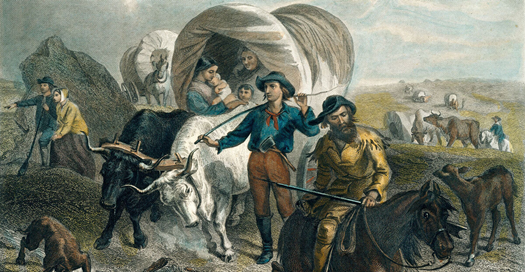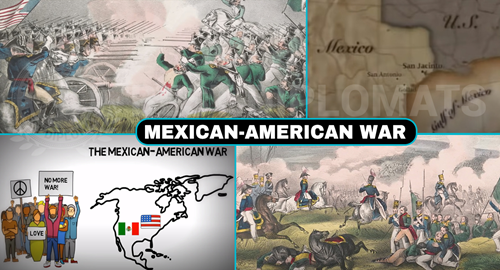Unit 5: Westward Expansion (1840-1890) Overview
Unit 5: Westward Expansion (1840-1890)

Unit 5: Westward Expansion (1840-1890)

Unit 5: Westward Expansion (1840-1890)
In 1803, President Thomas Jefferson purchased the territory of Louisiana from the French government for $15 million. The Louisiana Purchase stretched from the Mississippi River to the Rocky Mountains and from Canada to New Orleans, and it doubled the size of the United States. To Jefferson, westward expansion was the key to the nation’s health: He believed that a republic depended on an independent, virtuous citizenry for its survival, and that independence and virtue went hand in hand with land ownership, especially the ownership of small farms. (“Those who labor in the earth,” he wrote, “are the chosen people of God.”) In order to provide enough land to sustain this ideal population of virtuous yeomen, the United States would have to continue to expand. The westward expansion of the United States is one of the defining themes of 19th-century American history, but it is not just the story of Jefferson’s expanding “empire of liberty.” On the contrary, as one historian writes, in the six decades after the Louisiana Purchase, westward expansion “very nearly destroy[ed] the republic.”
Westward Expansion and Slavery
Meanwhile, the question of whether or not slavery would be allowed in the new western states shadowed every conversation about the frontier. In 1820, the Missouri Compromise had attempted to resolve this question: It had admitted Missouri to the union as a slave state and Maine as a free state, preserving the fragile balance in Congress. More important, it had stipulated that in the future, slavery would be prohibited north of the southern boundary of Missouri (the 36º30’ parallel) in the rest of the Louisiana Purchase.
However, the Missouri Compromise did not apply to new territories that were not part of the Louisiana Purchase, and so the issue of slavery continued to fester as the nation expanded. The Southern economy grew increasingly dependent on “King Cotton” and the system of forced labor that sustained it. Meanwhile, more and more Northerners came to believed that the expansion of slavery impinged upon their own liberty, both as citizens–the pro-slavery majority in Congress did not seem to represent their interests–and as yeoman farmers. They did not necessarily object to slavery itself, but they resented the way its expansion seemed to interfere with their own economic opportunity.
Westward Expansion and the Mexican War
 Despite this sectional conflict, Americans kept on migrating West in the years after the Missouri Compromise was adopted. Thousands of people crossed the Rockies to the Oregon Territory, which belonged to Great Britain, and thousands more moved into the Mexican territories of California, New Mexico and Texas. In 1837, American settlers in Texas joined with their Tejano neighbors (Texans of Spanish origin) and won independence from Mexico. They petitioned to join the United States as a slave state.
Despite this sectional conflict, Americans kept on migrating West in the years after the Missouri Compromise was adopted. Thousands of people crossed the Rockies to the Oregon Territory, which belonged to Great Britain, and thousands more moved into the Mexican territories of California, New Mexico and Texas. In 1837, American settlers in Texas joined with their Tejano neighbors (Texans of Spanish origin) and won independence from Mexico. They petitioned to join the United States as a slave state.
This promised to upset the careful balance that the Missouri Compromise had achieved, and the annexation of Texas and other Mexican territories did not become a political priority until the enthusiastically expansionist cotton planter James K. Polk was elected to the presidency in 1844. Thanks to the maneuvering of Polk and his allies, Texas joined the union as a slave state in February 1846; in June, after negotiations with Great Britain, Oregon joined as a free state.
That same month, Polk declared war against Mexico, claiming (falsely) that the Mexican army had “invaded our territory and shed American blood on American soil.” The war proved to be relatively unpopular, in part because many Northerners objected to what they saw as a war to expand the “slaveocracy.” In 1846, Pennsylvania Congressman David Wilmot attached a proviso to a war-appropriations bill declaring that slavery should not be permitted in any part of the Mexican territory that the U.S. might acquire. Wilmot’s measure failed to pass, but it made explicit once again the sectional conflict that haunted the process of westward expansion.
Westward Expansion and the Compromise of 1850
In 1848, the Treaty of Guadelupe Hidalgo ended the Mexican War and added more than 1 million square miles, an area larger than the Louisiana Purchase, to the United States. The acquisition of this land re-opened the question that the Missouri Compromise had ostensibly settled: What would be the status of slavery in new American territories? After two years of increasingly volatile debate over the issue, Kentucky Senator Henry Clay proposed another compromise. It had four parts: first, California would enter the Union as a free state; second, the status of slavery in the rest of the Mexican territory would be decided by the people who lived there; third, the slave trade (but not slavery) would be abolished in Washington, D.C.; and fourth, a new Fugitive Slave Act would enable Southerners to reclaim runaway slaves who had escaped to Northern states where slavery was not allowed.
This unit emphasizes the conflicts between Native Americans and people from the eastern United States who began to move west to mine, farm, and raise cattle.
Unit Focus
- Impacts of belief in manifest destiny and westward migration
- Methods and routes people used to travel westward
- Effects of American settlers in the Great Plains on Native American’s way of life
- Problems of farmers, cattle ranchers, and miners
- Effects of mining towns
Vocabulary
Lesson Reading

